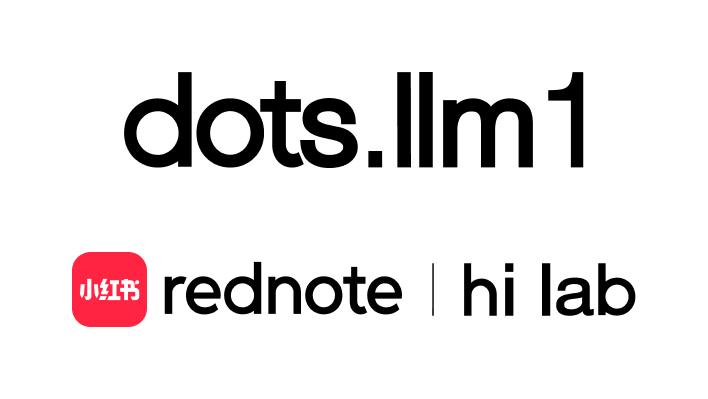dots1

🤗 Hugging Face | 📑 Paper
🖥️ Demo | 💬 WeChat (微信) | 📕 rednote
Visit our Hugging Face (click links above), search checkpoints with names starting with dots.llm1 or visit the dots1 collection, and you will find all you need! Enjoy!
News
- 2025.06.06: We released the
dots.llm1series. Check our report for more details!
1. Introduction
The dots.llm1 model is a large-scale MoE model that activates 14B parameters out of a total of 142B parameters, delivering performance on par with state-of-the-art models.
Leveraging our meticulously crafted and efficient data processing pipeline, dots.llm1 achieves performance comparable to Qwen2.5-72B after pretrained on 11.2T high-quality tokens without synthetic data. To foster further research, we open-source intermediate training checkpoints at every one trillion tokens, providing valuable insights into the learning dynamics of large language models.

2. Model Summary
This repo contains the base and instruction-tuned dots.llm1 model. which has the following features:
- Type: A MoE model with 14B activated and 142B total parameters trained on 11.2T tokens.
- Training Stages: Pretraining and SFT.
- Architecture: Multi-head Attention with QK-Norm in attention Layer, fine-grained MoE utilizing top-6 out of 128 routed experts, plus 2 shared experts.
- Number of Layers: 62
- Number of Attention Heads: 32
- Supported Languages: English, Chinese
- Context Length: 32,768 tokens
- License: MIT
The highlights from dots.llm1 include:
- Enhanced Data Processing: We propose a scalable and fine-grained three-stage data processing framework designed to generate large-scale, high-quality and diverse data for pretraining.
- No Synthetic Data during Pretraining: 11.2 trillion high-quality non-synthetic tokens was used in base model pretraining.
- Performance and Cost Efficiency:
dots.llm1is an open-source model that activates only 14B parameters at inference, delivering both comprehensive capabilities and high computational efficiency. - Infrastructure: We introduce an innovative MoE all-to-all communication and computation overlapping recipe based on interleaved 1F1B pipeline scheduling and an efficient grouped GEMM implementation to boost computational efficiency.
- Open Accessibility to Model Dynamics: Intermediate model checkpoints for every 1T tokens trained are released, facilitating future research into the learning dynamics of large language models.
3. Example Usage
Model Downloads
| Model | #Total Params | #Activated Params | Context Length | Download Link |
|---|---|---|---|---|
| dots.llm1.base | 142B | 14B | 32K | 🤗 Hugging Face |
| dots.llm1.inst | 142B | 14B | 32K | 🤗 Hugging Face |
Docker (recommended)
The docker images are available on Docker Hub, based on the official images.
You can start a server via vllm.
docker run --gpus all \
-v ~/.cache/huggingface:/root/.cache/huggingface \
-p 8000:8000 \
--ipc=host \
rednotehilab/dots1:vllm-openai-v0.9.0.1 \
--model rednote-hilab/dots.llm1.inst \
--tensor-parallel-size 8 \
--trust-remote-code \
--served-model-name dots1
Then you can verify whether the model is running successfully in the following way.
curl http://localhost:8000/v1/chat/completions \
-H "Content-Type: application/json" \
-d '{
"model": "dots1",
"messages": [
{"role": "system", "content": "You are a helpful assistant."},
{"role": "user", "content": "Who won the world series in 2020?"}
],
"max_tokens": 32,
"temperature": 0
}'
Inference with huggingface
We are working to merge it into Transformers (PR #38143).
Text Completion
import torch
from transformers import AutoTokenizer, AutoModelForCausalLM, GenerationConfig
model_name = "rednote-hilab/dots.llm1.base"
tokenizer = AutoTokenizer.from_pretrained(model_name)
model = AutoModelForCausalLM.from_pretrained(model_name, device_map="auto", torch_dtype=torch.bfloat16)
text = "An attention function can be described as mapping a query and a set of key-value pairs to an output, where the query, keys, values, and output are all vectors. The output is"
inputs = tokenizer(text, return_tensors="pt")
outputs = model.generate(**inputs.to(model.device), max_new_tokens=100)
result = tokenizer.decode(outputs[0], skip_special_tokens=True)
print(result)
Chat Completion
import torch
from transformers import AutoTokenizer, AutoModelForCausalLM, GenerationConfig
model_name = "rednote-hilab/dots.llm1.inst"
tokenizer = AutoTokenizer.from_pretrained(model_name)
model = AutoModelForCausalLM.from_pretrained(model_name, device_map="auto", torch_dtype=torch.bfloat16)
messages = [
{"role": "user", "content": "Write a piece of quicksort code in C++"}
]
input_tensor = tokenizer.apply_chat_template(messages, add_generation_prompt=True, return_tensors="pt")
outputs = model.generate(input_tensor.to(model.device), max_new_tokens=200)
result = tokenizer.decode(outputs[0][input_tensor.shape[1]:], skip_special_tokens=True)
print(result)
Inference with vllm
vLLM is a high-throughput and memory-efficient inference and serving engine for LLMs. Official support for this feature is covered in PR #18254.
vllm serve dots.llm1.inst --port 8000 --tensor-parallel-size 8
An OpenAI-compatible API will be available at http://localhost:8000/v1.
Inference with sglang
SGLang is a fast serving framework for large language models and vision language models. SGLang could be used to launch a server with OpenAI-compatible API service. Official support for this feature is covered in PR #6471.
Getting started is as simple as running:
python -m sglang.launch_server --model-path dots.llm1.inst --tp 8 --host 0.0.0.0 --port 8000
An OpenAI-compatible API will be available at http://localhost:8000/v1.
4. Evaluation Results
Detailed evaluation results are reported in this 📑 report.
Citation
If you find dots.llm1 is useful or want to use in your projects, please kindly cite our paper:
@article{dots1,
title={dots.llm1 Technical Report},
author={rednote-hilab},
journal={arXiv preprint arXiv:TBD},
year={2025}
}
- Downloads last month
- 230
Model tree for rednote-hilab/dots.llm1.inst
Base model
rednote-hilab/dots.llm1.base